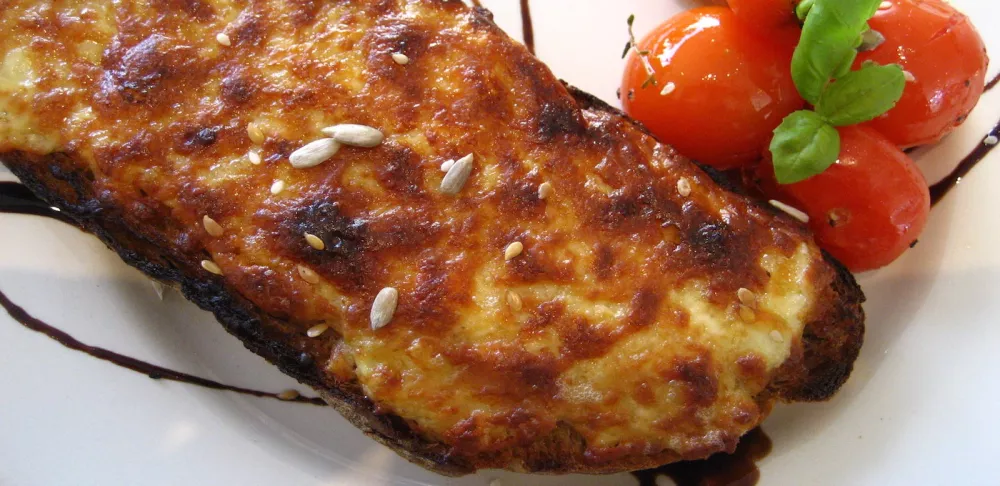I spoke to the proprietor of NYC’s only Welsh pub about the crave-able cheese toast known as Welsh Rarebit, including answering questions such as: how it came to be, how to make it, and why it’s called that.
There is a 16th century joke whose punchline claims that there are no Welshmen in heaven because they were lured outside of the pearly gates by cheese.
I’ve never taken a DNA test, but given this fact, I deeply suspect Welsh heritage, not only because of a chromosome-level love of cheese, but also by the fact that I’ve been eating a bechamel-based cheese sauce on toast since I was young, in what I just thought was an ingenious and elegant grilled cheese variation on my mother’s part. It was only very recently that I learned that this brilliant but simple concoction is called Welsh rarebit, national comfort food of Wales.
While English and Irish pubs are fairly ubiquitous in American cities, seeking out Welsh-inspired expertise is a little harder to come by, but fortunately for New York City residents, and especially those in the Astoria neighborhood of Queens, not impossible.
“That’s rarebit,” confirms Carrie Spiller, co-owner and co-chef of Snowdonia, New York City’s only Welsh-inspired pub, when I explained the beloved cheesy toast dish from my childhood. (While the name sounds like it could be something of a Canadian ski lodge, Snowdonia is a region in Northern Wales.) Inspired by a family connection and numerous trips to Wales, Spiller was motivated to bring a taste of Wales to the U.S.
With her input, we get to know the ins and outs of this enigmatic dish.
Welsh-Inspired Cuisine and What’s in a Name
“Welsh food is comfort food” states Snowdonia’s menu, and Spiller explains what makes it so: “It’s really about using good, fresh ingredients that are handy and that you don’t have to go out of your way for. And just putting it all together in a hearty, tasty way.”
Case in point: rarebit, which you can probably make right now from basic ingredients on hand in your cupboard or fridge. Its seemingly oddball moniker, which can be traced back until at least the 15th century, is believed to be a riff on the word “rabbit,” another nod to the Welsh sense of humor, given that it is a meatless dish.
Regardless of its naturally vegetarian pedigree, this typical peasant meal was given a meat-forward name because of its potential for nonetheless robust, meaty flavors. (Also of note, Wales claims a poor man’s “sausage” called glamorgans, which are also made from cheese.)
Related Reading: Understanding Cheese Rinds
The Cheese Sauce
“The traditional rarebit is a little sloppy,” says Spiller. “It’s typically a cheese sauce, like a bechamel or mornay, and you can flavor it from that point however you wish.”
Common inclusions in recipes for rarebit are elements that deepen and enhance the cheese sauce flavor such as beer, Worcestershire, mustard, cayenne, or nutmeg.
“A bold porter gives it a really nice base,” says Spiller.
The dish may be finished under a broiler for additional, caramelized effect, but this isn’t a mandatory step.
Also in keeping with the Welsh “whatever is on hand” ethos, Spiller makes no demands about specific styles or brands of cheese, save a few guiding principles.
“You want that flavor of the cheese to come through,” she says. “We use a mix of cheeses, including a hard cheese for saltiness, a softer cheese for texture, and a couple of sharp cheeses for flavor.”
Sharpness in cheese refers to its acidity levels, especially in cheddars. Given the milky base of rarebit’s sauce, this sharpness provides a good contrast and allows the cheese flavor to shine through. Bonus points perhaps for a savory Welsh cheddar such as Collier’s in your rarebit preparation, but again, Spiller maintains that using what you’ve got is more to the point.
Related Reading: Understanding Cheddar
The Bread
Traditionally, rarebit would employ a robust brown bread, grain bread, or even soda bread. Soda breads are common in the UK and Ireland as hearty staple breads that come together quickly since they utilize baking soda, which relies on acid and heat to rise, rather than yeast, which relies on time, giving the bread a denser, almost scone-like consistency.
If you’re going for full Welsh immersion, “another traditional dish is laverbread,” Spiller explains.
Laverbread is a loose interpretation of bread, and is more of a patty formed of oatmeal and seaweed, taking advantage of that which is abundant in a coastal nation.
“It really satisfies,” says Spiller, and offers a briny, almost umami quality to rarebit, doubling down on its meaty characteristics while remaining meat-free.
Seaweed, or dulse, can be easily incorporated into a traditional yeast bread or soda bread recipe, but again, in keeping with the simple-but-hearty approach, whatever bread is in your basket will work just fine.
The Toppings
My childhood version of rarebit is one where bacon and sliced tomato share the toast with the cheese sauce, but its humble roots make no such demands, and rarebit’s official definition ends with cheese on toast. But people, Welsh and otherwise, can make it their own.
“Just add a flavor layer,” suggests Spiller. “So what do you have? Whatever it is, you just make it work.”
As befits a quirky Astoria pub, where “Labyrinth” was playing on the TVs, silverware is available in a repurposed haggis can, and the back bar is adorned with the longest word in Welsh, (Llanfairpwllgwngyllgogerychwyrndrobwyllllantysiliogogogoch), Snowdonia’s rarebit comes with a plethora of gastro pub toppings: candied maple bacon, roasted red peppers, and olive tapenade.
“That’s what we came away with in Wales,” says Spiller. “Use what you have. And just find an interesting way of putting it together.”
Related Reading:5 Major Cheese Styles Every Chef Should Know






